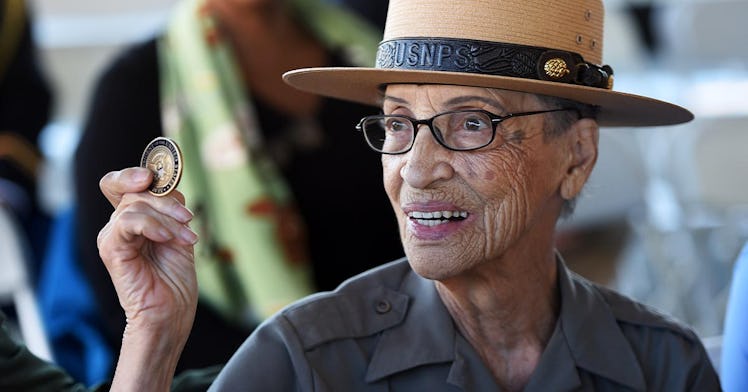Schedule a Tour From This Badass 100-Year-Old National Park Ranger
Betty is the oldest national park ranger and has a fascinating history with the Rose the Riveter/World War II Home Front National Historical Park.

Some of us know from a very young age what career path we want to take. And others seem to fall into it like destiny had something to do with it. America’s oldest National Park Ranger didn’t know right away what she wanted to be when she grew up. But as she reflects on her incredible career while celebrating her 100th birthday, it’s clear this was the job she was destined to fill.
Betty Reid Soskin works for the National Park Service as a Park Ranger, and she’s a celebrity in her own right. Despite the fact that she’s 100 years old, she still gives tours at Richmond, California’s Rose the Riveter/World War II Home Front National Historical Park. If you want to get a tour from a living legend who will give you information about another legend, you should know that her tour schedule of the park is always booked up in advance for weeks and months, so you’ll have to plan ahead. And it has everything to do with Betty as a person.
According to a profile interview in The New York Times, Betty has a fascinating story. She began her career at the National Park Service at 85 years old. But her life before led her to the role in incredible ways.
Born in 1921 in Detroit, she began working as a fire clerk in a segregated union hall during World War II. After, she became a community and political activist working with Antiwar movements and the Black Panthers. At several other times in her life, she also worked as an accomplished musician, a blogger, a business owner, and a political aide.
Her work as a political aide steered her in the direction that led her to become the oldest working National Park Ranger. She sat in on early planning meetings for Rosie the Riveter / World War II Home Front National Historical Park. During the first meeting, she called out that she had a “love-hate relationship” with the Rosie the Riveter icon the park was named after, saying that she saw it telling a white woman’s story.
During the war, she had worked in a segregated unit at the “historically all-white Boilermakers union, which had resisted demands to allow full membership to Black workers,” The New York Times reports. But, as the only person of color in the room, she was vocal about ensuring the park would tell the story of many. She stayed in the room, always speaking up, and that’s why the park is what it is today.
And Betty’s work with the park continued from there: first a community liaison, then a seasonal tour guide, landing in her full-time interpretive ranger role in 2007. “When I became a ranger,” she said, “I was taking back my own history.”
“Without Betty’s influence, we probably would not have told various previously marginalized stories in as much depth,” said Tom Leatherman, who has been park superintendent since 2010. And it’s that same energy Betty shares when she’s giving tours today.
“Betty has an amazing ability to share her own story in a really personal and vulnerable way — not so people know more about her, but so they understand that they too have a story,” Tom said. “We all have a history — and it’s just as important as the history we learn in school.”
A college once referred to Betty as “sort of like Bette Davis, Angela Davis and Yoda all rolled into one.” And with that, it’s no surprise that she’s still one of the most sought-after Park Rangers.
So if you want to go see this living legend, make sure you check out the National Parks website. You don’t want to miss it.